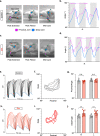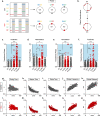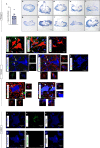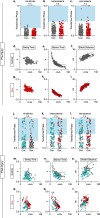Silencing long ascending propriospinal neurons after spinal cord injury improves hindlimb stepping in the adult rat
- PMID: 34854375
- PMCID: PMC8639151
- DOI: 10.7554/eLife.70058
Silencing long ascending propriospinal neurons after spinal cord injury improves hindlimb stepping in the adult rat
Abstract
Long ascending propriospinal neurons (LAPNs) are a subpopulation of spinal cord interneurons that directly connect the lumbar and cervical enlargements. Previously we showed, in uninjured animals, that conditionally silencing LAPNs disrupted left-right coordination of the hindlimbs and forelimbs in a context-dependent manner, demonstrating that LAPNs secure alternation of the fore- and hindlimb pairs during overground stepping. Given the ventrolateral location of LAPN axons in the spinal cord white matter, many likely remain intact following incomplete, contusive, thoracic spinal cord injury (SCI), suggesting a potential role in the recovery of stepping. Thus, we hypothesized that silencing LAPNs after SCI would disrupt recovered locomotion. Instead, we found that silencing spared LAPNs post-SCI improved locomotor function, including paw placement order and timing, and a decrease in the number of dorsal steps. Silencing also restored left-right hindlimb coordination and normalized spatiotemporal features of gait such as stance and swing time. However, hindlimb-forelimb coordination was not restored. These data indicate that the temporal information carried between the spinal enlargements by the spared LAPNs post-SCI is detrimental to recovered hindlimb locomotor function. These findings are an illustration of a post-SCI neuroanatomical-functional paradox and have implications for the development of neuronal- and axonal-protective therapeutic strategies and the clinical study/implementation of neuromodulation strategies.
Keywords: locomotion; neuronal silencing; neuroscience; propriospinal neurons; rat; spinal cord injury; viral vector.
© 2021, Shepard et al.
Conflict of interest statement
CS, AP, BB, MV, RZ, DB, JM, AR, SW, DM No competing interests declared
Figures










Similar articles
-
Long ascending propriospinal neurons are heterogenous and subject to spinal cord injury induced anatomic plasticity.Exp Neurol. 2024 Mar;373:114631. doi: 10.1016/j.expneurol.2023.114631. Epub 2023 Dec 7. Exp Neurol. 2024. PMID: 38070723 Free PMC article.
-
Silencing long-descending inter-enlargement propriospinal neurons improves hindlimb stepping after contusive spinal cord injuries.Elife. 2023 Dec 15;12:e82944. doi: 10.7554/eLife.82944. Elife. 2023. PMID: 38099572 Free PMC article.
-
Long ascending propriospinal neurons provide flexible, context-specific control of interlimb coordination.Elife. 2020 Sep 9;9:e53565. doi: 10.7554/eLife.53565. Elife. 2020. PMID: 32902379 Free PMC article.
-
Transplants and neurotrophic factors increase regeneration and recovery of function after spinal cord injury.Prog Brain Res. 2002;137:257-73. doi: 10.1016/s0079-6123(02)37020-1. Prog Brain Res. 2002. PMID: 12440372 Review.
-
Propriospinal Neurons: Essential Elements of Locomotor Control in the Intact and Possibly the Injured Spinal Cord.Front Cell Neurosci. 2019 Nov 12;13:512. doi: 10.3389/fncel.2019.00512. eCollection 2019. Front Cell Neurosci. 2019. PMID: 31798419 Free PMC article. Review.
Cited by
-
Chemogenetic modulation of sensory afferents induces locomotor changes and plasticity after spinal cord injury.Front Mol Neurosci. 2022 Aug 26;15:872634. doi: 10.3389/fnmol.2022.872634. eCollection 2022. Front Mol Neurosci. 2022. PMID: 36090254 Free PMC article.
-
Widening spinal injury research to consider all supraspinal cell types: Why we must and how we can.Exp Neurol. 2021 Dec;346:113862. doi: 10.1016/j.expneurol.2021.113862. Epub 2021 Sep 11. Exp Neurol. 2021. PMID: 34520726 Free PMC article. Review.
-
Neuroplasticity and regeneration after spinal cord injury.N Am Spine Soc J. 2023 Jun 8;15:100235. doi: 10.1016/j.xnsj.2023.100235. eCollection 2023 Sep. N Am Spine Soc J. 2023. PMID: 37416090 Free PMC article.
-
Advances in molecular therapies for targeting pathophysiology in spinal cord injury.Expert Opin Ther Targets. 2023 Mar;27(3):171-187. doi: 10.1080/14728222.2023.2194532. Epub 2023 Apr 5. Expert Opin Ther Targets. 2023. PMID: 37017093 Free PMC article. Review.
-
Long ascending propriospinal neurons are heterogenous and subject to spinal cord injury induced anatomic plasticity.Exp Neurol. 2024 Mar;373:114631. doi: 10.1016/j.expneurol.2023.114631. Epub 2023 Dec 7. Exp Neurol. 2024. PMID: 38070723 Free PMC article.
References
-
- Arber T, Ruffion A, Terrier JE, Paparel P, Morel Journel N, Champetier D, Dominique I. Efficacy and security of continent catheterizable channels at short and middle term for adult neurogenic bladder dysfunction. Progres En Urologie. 2019;29:1047–1053. doi: 10.1016/j.purol.2019.08.278. - DOI - PubMed
Publication types
MeSH terms
Grants and funding
LinkOut - more resources
Full Text Sources
Medical

